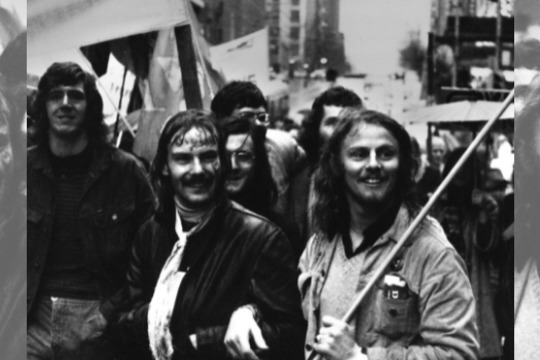Showing 18 items matching "models"
-

Out of the Closets, Into the Streets
... oppression of gay people starts in the most basic unit of society, the family, consisting of the man in charge, a slave as his wife, and their children on whom they force themselves as the ideal models. The very form of the family works against ...This project documents the very beginning of the Gay Liberation Movement in Melbourne.
Through the manifestos, photographs, flyers and recollections of those who were part of the movement, this digital story explores the ways in which gay people found their voice in Melbourne, and refused to pass for straight anymore.
Gay Liberation had both local and imported roots. Internationally the New York City Stonewall riots in 1969 sparked off a new phase of radical gay politics, drawing on the momentum of activist organisations and protests across America throughout the 1960s, but locally few people took immediate notice, though fledgling advancements in homosexual law reform had developed within the civil liberties movement.
In Melbourne, the short-lived Daughters of Bilitis (later Australasian Lesbian Movement) arrived quietly on the scene in January 1970, gaining media coverage but limited influence. The real start to the Australian gay movement occurred in September 1970 with the formation of the Campaign Against Moral Persecution, or CAMP, in Sydney. Within two years there were CAMP branches in most Australian capital cities, with the Melbourne branch established in January 1971, soon renamed Society Five. However, despite the success of these organisations in counselling and socialising and later law reform, the relatively closeted nature of Society Five was never radical enough for some activists.
Gay Liberation arrived in Australia first in Sydney in 1971 and soon after in Melbourne and other states. By 1972 small Gay Liberation groups were springing up around the country. The differences between Gay Liberation and Society Five were in practice small, but those in Gay Liberation prided themselves on their commitment to bringing about radical social change.
Influenced by the counter-cultural movements and radical political movements of the 1970s, the politics of gay liberation became an all-encompassing liberation, an ‘embodied politics’ that saw liberation in all aspects of one’s life, from households to classrooms, sexual relations to workplaces, clothing to protests. Young gay people had found their voice, and group members organised the demonstrations, marches and public events illustrated in this story.
This Digital Story draws on material produced for the Australian Lesbian and Gay Archives (now Australian Queer Archives) exhibition Out of the Closets, Into the Streets: Histories of Melbourne Gay Liberation, curated and written by Nick Henderson, drawing on the original research of Graham Willett. A complementary documentary film, additional interviews, and written curatorial and audio content was produced by documentary film makers Wind & Sky Productions.
-
 Jary Nemo and Lucinda Horrocks
Jary Nemo and Lucinda HorrocksCollections & Climate Change
The world is changing. Change is a natural part of the Earth’s cycle and of the things that live on it, but what we are seeing now is both like and unlike the shifts we have seen before.
Anthropogenic change, meaning change created by humans, is having an impact on a global scale. In particular, human activity has altered the composition of the Earth’s atmosphere, causing the world’s climate to change.
Already in the state of Victoria we are seeing evidence of this change around us. In the natural world, coastal waters are warming and bringing tropical marine species to our bays. Desert animals are migrating to Victoria. Alpine winters are changing, potentially putting plants and animals at risk of starvation and pushing species closer to the margins. In the world of humans, island and coastal dwellers deal with the tangible and intangible impacts of loss as sea levels rise, bush dwellers live with an increased risk of life-threatening fires, farmers cope with the new normal of longer droughts, and we all face extreme weather events and the impacts of social and economic change.
This Collections and Climate Change digital story explores how Victoria’s scientific and cultural collections help us understand climate change. It focuses on three Victorian institutions - Museums Victoria, the Royal Botanic Gardens Victoria and Parks Victoria. It looks at how the information gathered and maintained by a dedicated community of researchers, curators, scientists, specialists and volunteers can help us understand and prepare for a hotter, drier, more inundated world.
The story is made up of a short documentary film and twenty-one examples highlighting how botanical records, geological and biological specimens and living flora and fauna provide a crucial resource for scientists striving to map continuity, variability and change in the natural world. And it helps us rethink the significance of some of Victoria’s cultural collections in the face of a changing climate.
